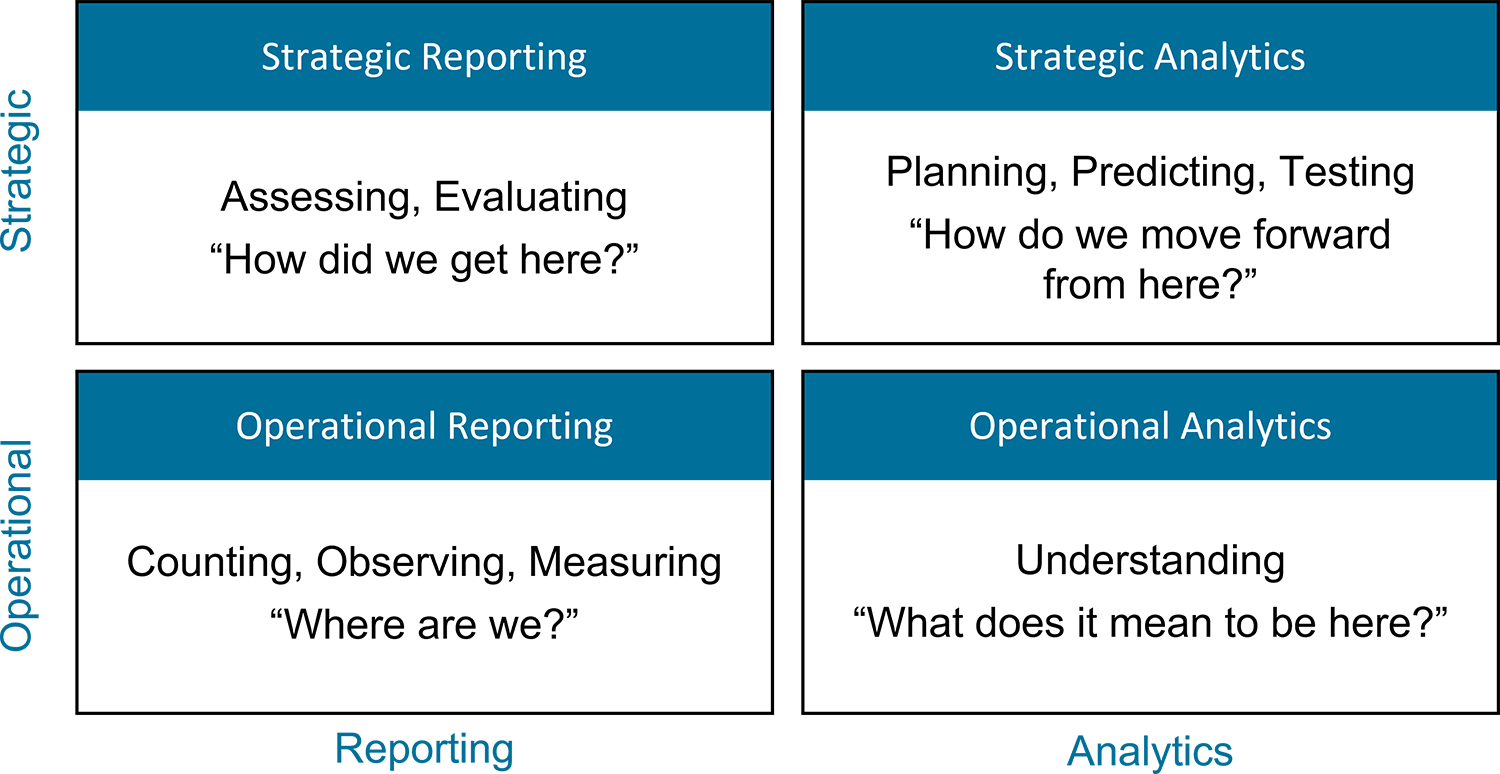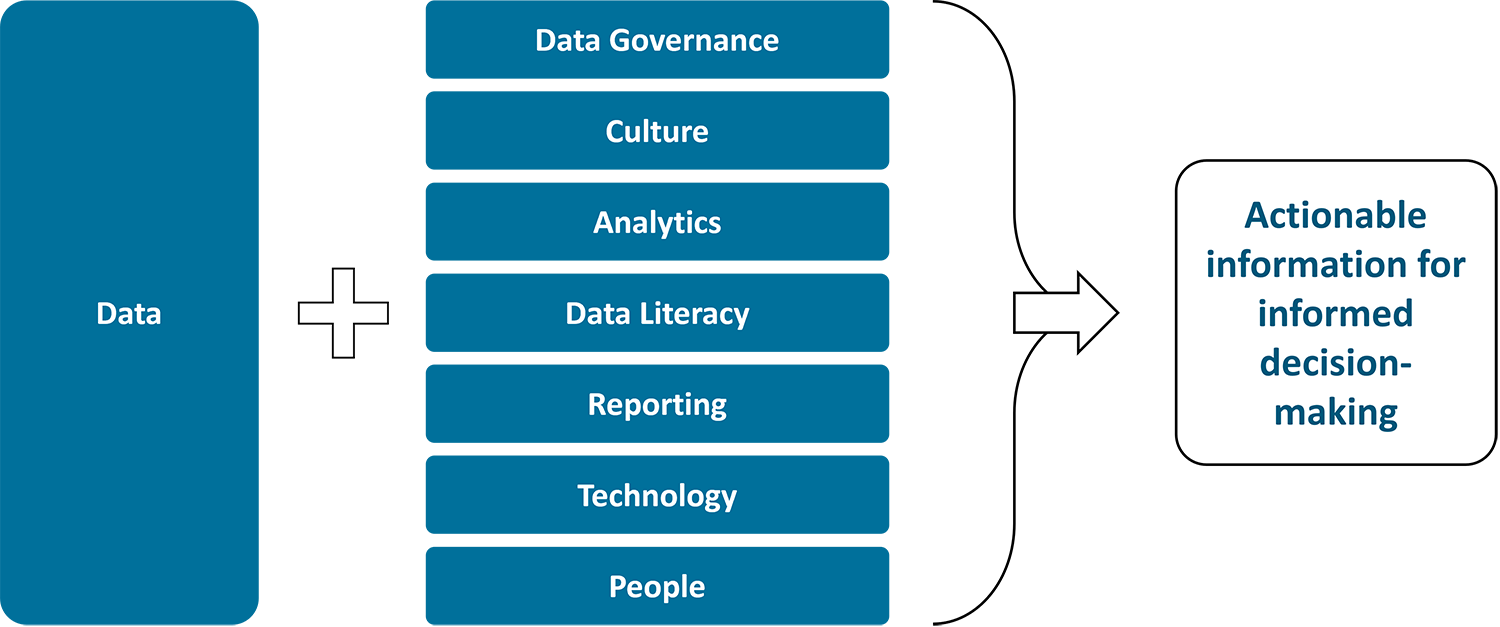An effective institutional analytics program has become essential to providing proactive student services and informing strategic actions. Leveraging a modern framework that describes the elements of a mature data and analytics program can help colleges and universities obtain actionable insights.

For higher education institutions, harnessing the power of analytics—using data to inform and proactively guide institutional actions and decisions—is no longer an optional "extra." A strong analytics capability has become a necessity that allows colleges and universities to provide the services that students expect and to predict and respond to change.
In the 2023 EDUCAUSE Review Top 10 IT Issues article, four of the Top 10 issues involve data and analytics. The article highlights the importance not only of data collection but also of data use:
Analytics leaders are working to create the "Ultra-Intelligent Institution." Data is as indispensable as technology for operating a college or university. But what makes data essential to modern management is the uses that are made of it. Today's data professionals are focused on working with management to complete the data journey from "what" to "so what" to "now what" (Issue #7). In particular, efforts are focusing on improving the student experience (Issue #4) and expanding enrollments (Issue #6).Footnote1
Many institutions are at a junction with the evolution of their use of data and analytics and fulfillment of this vision. While some have successfully implemented robust institutional analytics programs, others are still trying to figure out the pieces that need to be brought together to effectively move forward. This article presents a modern framework that looks at the elements of a mature data and analytics program and the guiding principles and key competencies needed to evolve institutional capabilities in using data to provide actionable strategic insights.
Understanding Current Institutional Analytics Capabilities
Colleges and universities have access to more data than ever. Data and sophisticated analytics are often being used to inform enrollment, student retention, and other key areas. Work may be underway to start building more sophisticated institutional dashboards.
While these are positive and important steps in a college or university's maturity in the use of data and analytics, there is often a lack of a shared culture of data literacy, transparency, and consistency in the use of data to inform institutional decisions, track critical KPIs, and assess strategic outcomes. Some data often remains inaccessible or is viewed as the purview of specific data owners. Many times, the primary focus of data scientists and analysts is on enrollment and compliance reporting, leaving limited bandwidth for other areas. There may be a growing need for a data governance program.
Understanding where an institution stands on its analytics journey is an important starting point. One way to do this is to utilize the EDUCAUSE "Analytics Institutional Self Assessment" to help develop a shared understanding of current institutional analytics maturity.Footnote2 This tool can focus discussions between key stakeholders, including college and university leaders, to create a shared understanding of current institutional capabilities, approaches, strengths, and gaps.
Supporting Whole Institution Analytics and Informed Decision-Making
Figure 1 shows a four-quadrant Data and Analytics Maturity Model that illustrates how institutions can use reporting and analytics.

The Data and Analytics Maturity Model can be used to assess the widespread use of analytics for planning, predicting, testing, and understanding versus the more focused use of analytics for assessing, evaluating, counting, observing and measuring. For example, while there might currently be some limited use of operational and strategic analytics in areas around enrollment and retention, operational reporting is often still the primary way data is consumed and shared. Analytics professionals are good at measuring the state of an institution and its students by counting, enumerating, and measuring applications, enrollments, housing assignments, and GPAs. Although this certainly is foundational to day-to-day work, operational reporting surfaces only a fraction of the value colleges and universities can unlock from their institutional data.
Maturing how institutional stakeholders manage, use, and derive actionable information from data relies on a rethinking of the structural organization around data and analytics. A coordinated approach includes adhering to a core set of eight guiding principles and addressing institutional ability to execute in eight key competency areas.
Guiding Principles
The following eight principles can help create the foundations necessary to utilize data for actionable insights across an institution.
- Data should be timely: being kept up-to-date and refreshed weekly, daily, hourly—as often as is needed.
- Data should be consistent: ensuring that definitions, calculations, meanings, and interpretations are standardized and that measurements, projections, and metrics are based on commonly understood concepts.
- Data should be trusted: having been validated and supported by functional areas, with intentional steps taken to continuously ensure data accuracy.
- Data should be relevant: providing the right level of detail and insight into the most urgent and important questions.
- Data should be interactive: supporting direct exploration by users through dynamic dashboards and reports, including the ability to drill down from aggregate data into details.
- Data should be connected: being transformed into information that can be directly used to drive strategic and operational decisions, with analytics priorities set at the institutional level and in harmony with the strategic plan.
- Data should be accessible: providing access to relevant information at the right time, to those who need it, and with the ability to drill up or down as necessary and appropriate.
- Data should be actionable: addressing all types of questions covered in the Data and Analytics Maturity Model in support of data-informed decision-making.
Principle #8 is perhaps the most important. Actionable data should be able to provide insights and inform strategy rather than describing what has already happened. Actionable data can be used to inform decision-making and guide institutional actions.
Key Competencies
Using these eight guiding principles, institutions need to be able to successfully execute each of the eight key competencies shown in figure 2. This will mature a data and analytics program and enable institutional leaders to fully leverage actionable information to inform their decision-making.

Data
A modern institutional data environment needs to be established to integrate institutional information into one repository. Data from key institutional systems of record needs to flow into this environment on a frequent basis and be organized in ways to facilitate reporting and analytics.Footnote3 This institutional data needs to be able to be enriched with external data sources, such as the National Student Clearinghouse, federal datasets on education, and data available in voluntary data-sharing agreements with other institutions.
Care should be taken not to let perfection be the enemy of progress. Institutions are encouraged to approach this work incrementally, to treat decisions as reversible, and to be comfortable moving ahead without all the answers. Historical approaches to data architecture and modeling often overfocus on up-front design and complexity. It may also be wise to avoid large vendor decisions and implementations until later in the data journey.
Data Governance
A workable, collaborative data governance process needs to be established and maintained in partnership with data stewards and institutional leadership. The process should focus on the dual goals of standardization and policy. The standardization work includes defining terms, determining calculations, and representing the data. Concurrently, stakeholders should agree on standards for identifying groups, populations, and cohorts and should create common terminology for filtering and selection.
Culture
Building strong community among the data experts across all functional areas is important to breaking down institutional barriers and silos around data. A key component is shifting the culture from one of data ownership toward one of shared stewardship. This culture shift is critical for building confidence and trust in a singular repository of institutional data and is supported by a shared focus on data quality.
Analytics
Analytics, the practice of statistically and mathematically analyzing aggregated data, needs to be reframed from a siloed activity to a cabinet-directed, campus-wide strategic priority. The analytics team must be viewed as a center of innovation, not just as a reporting and compliance function. As the institution builds its capabilities in this area, the reliance on third-party vendors for support could be diminished. Vendors can then focus primarily on external comparisons and insights, while internal resources can focus on best understanding information about the institution.
Data Literacy
A plan for building data literacy and skills among faculty, staff, and students—including training and support for those using data analytics in their work—will help to create a more substantial data culture. A baseline of data literacy needs to be developed throughout the organization to ensure that key stakeholders are equipped to read, understand, and communicate data in context and have a shared understanding of the underlying methods used to extract meaning from the data. Given that there is much more data available than in the past, institutions need to make a corresponding effort to ensure that people have the skills to properly understand and leverage that data.
There can also be a tendency to favor past institutional knowledge or history, in a belief that the true knowledge of an institution lies with the perspectives of the people, not the data. But there are different categories of knowledge, and institutional leaders must not shy away from developing a deeper understanding of the data and of the analytical and statistical processes necessary to leverage it, even if doing so challenges what was held as historical institutional knowledge and beliefs.
Reporting
Reporting is the delivery mechanism, be it a static list or a dynamic dashboard. It is a critical step in the process of delivering actionable data. Analytics professionals must develop reporting mechanisms using modern visualization tools that connect directly with leadership so that strategic value can be derived from the data.
Technology
Technology, a foundational component of a data analytics program, involves the systems and tools used to collect, store, and analyze data. This includes data warehouses, visualization tools, and machine learning platforms. The institution needs to invest in building a robust, modern data-warehousing environment. Colleges and universities should consider using tools that are taught and supported in the business, mathematics, and computer science programs, creating opportunities for including faculty and students in analytics work.
People
Successfully carrying out these competencies requires having the right organization, skillsets, and focus and envisioning the data and analytics work as a cross-institution activity. The data analysis team needs diverse skills, including data literacy, data governance, analytics and visualization, and change and project management. By understanding current analytics capabilities and working to build a mature data and analytics program, stakeholders can effectively use data to inform decision-making and improve the student experience. Many of the right people for this work may already be part of the program, but colleges and universities must have the best structure and support mechanisms in place to support their efforts.
Putting These Concepts into Action
When used collectively, the Data and Analytics Maturity Model, the eight guiding principles, and the eight key competencies provide a modern framework that can help assess, discuss, and develop a strategic approach to institutional analytics.
Although every institution is different, much of this work starts with the adoption of a centralized mindset:
- Re-envision the data, reporting, and analytics team as a singular, campus-wide provider with clearly defined leadership accountability and a strong service-oriented mission that aligns with institutional goals.
- Ensure that talented staff can work together as a coordinated, collaborative, consistent, efficient, and scalable team. Invest in growing the team's analytical capabilities internally while intentionally leveraging strategic third-party partnerships.
- Empower and support this team to lead both institutional data governance and data literacy efforts, addressing both policy and culture.
- Leverage the skills and technologies in the IT organization and engage with the IT team as a strategic partner in this effort.
Maturing an institutional analytics framework to help support the vision of the "Ultra-Intelligent Institution" takes work. Applying some of the concepts of the modern institutional analytics framework can help provide a pathway for success.
Notes
- Susan Grajek and the 2022–2023 EDUCAUSE IT Issues Panel, "Top 10 IT Issues, 2023: Foundation Models," EDUCAUSE Review, October 31, 2022. Jump back to footnote 1 in the text.
- EDUCAUSE, "Analytics Institutional Self Assessment," July 29, 2021. Jump back to footnote 2 in the text.
- See Betsy Tippens Reinitz et al., 2022 EDUCAUSE Horizon Report: Data and Analytics Edition, research report (Boulder, CO: EDUCAUSE, 2022). The appendix lists a number of good resources for learning more about modern data architectures. Jump back to footnote 3 in the text.
David Weil is Chief Information Officer at Ithaca College.
Casey Kendall is Executive Director of Applications & Infrastructure at Ithaca College.
Rob Snyder is Director of Enterprise Applications, Data, and Integrations at Ithaca College.
© 2023 David Weil, Casey Kendall, and Rob Snyder. The text of this work is licensed under a Creative Commons BY-NC-ND 4.0 International License.
